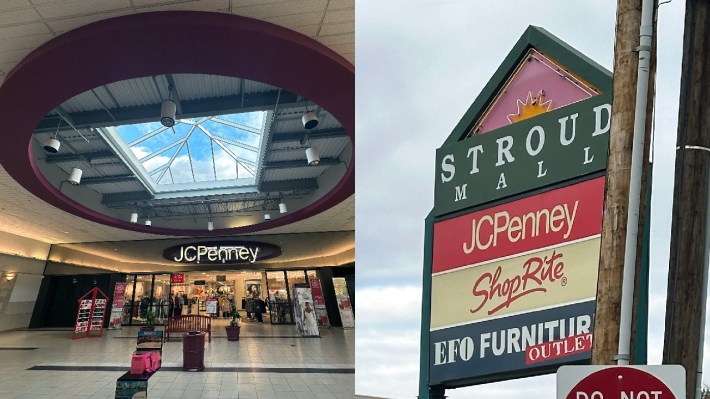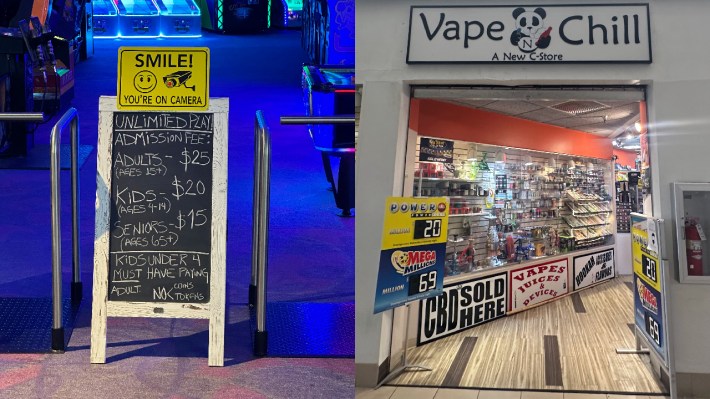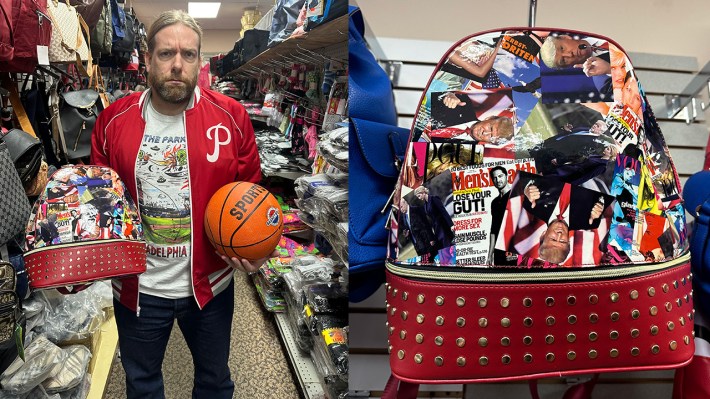The Hess Brothers ruled Allentown retail for decades. Brothers Max and Charles Hess opened their department store on Hamilton Street in 1897, and like many such stores around the country, Hess’s became a shopping sensation. “Hess’s was the beating, thriving heart of Allentown,” Lehigh Valley historian Frank Whelan said in 2008, when he released a photo book about the store. Max Hess Jr. took over the store in 1932 and proved to be a merchandising and promotional wizard. Hess’s did more sales than any department store in a city under 200,000 residents; Hess was praised as one of “America’s Twelve Master Salesmen” in a 1952 book.
But shopping habits began to change as shoppers moved to the suburbs. Master salesman that he was, Max Hess Jr. must have seen this. He sold the store to Allentown trucking magnate Philip Berman for $16 million in 1968. Berman and his wife, Muriel, were fanatical patrons of the arts, so much so that by the 1980s Allentown residents were furious about all the art he’d put around town. These weren’t pieces by no-names, either. Allentown residents particularly hated Mark Di Suvero’s “Victor’s Lament,” which was placed at Muhlenberg College, and Paul Sisko’s “Cube and Thread,” which old news sources call “Cube and Screw.” It does look more like a screw.
The Sisko work was hated when it was installed in 1980, but eventually became enough of an institution that Allentown’s mayor protested its scheduled removal. In 1988 someone in Allentown attempted to destroy Igael Tumarkin’s sculpture “Theseus” by driving a car into it; two years earlier a petition with hundreds of signatures called for its removal. (It’s still up.) Philip died in 1997 and Muriel in 2004. Their legacy continues in Pennsylvania. In addition to the Allentown sculpture garden and other public art around town, the Berman Museum at Ursinus College has several wonderful exhibitions every year.
But in 1968, Philip Berman’s main business was retail. He could see that the game was changing, and that malls were becoming the new shopping destination. In 1966, the Whitehall Mall had opened in suburban Allentown with several department store anchors, and Berman wanted to make sure Hess’s wasn’t left out. In 1976, Hess’s and the Montgomery Development Company announced that they would develop the Stroud Mall in Stroudsburg, Pennsylvania. It was in a good spot, easily accessible from the Poconos and over the river in New Jersey. Hess’s opened in July of 1977; the mall had its grand opening the following year. A J.C. Penney anchor store opened in 1978 as well; this one replaced a downtown location. That’s still there, though the company styles it “JCPenney” now.
Hess’s is not. Berman sold the chain, then 16 stores, to Crown American in 1979. The chain expanded to almost 80 stores before failing; in 1994, all remaining Hess’s stores were sold to either The Bon-Ton or Macy’s. But the Stroud Mall is still there, and is now operated by CBL Properties. Since we had such a nice time at the American Dream mall in North Jersey, while in the Poconos recently for our retreat, we decided to try another mall. This one is not quite the American Dream, but we had another good trip. Welcome to Dan and Dave Go To The Mall, Part 2: Stroud Mall.

Dan: Hi Dave! Thanks for joining me on another shopping excursion, this time to a late 1970s mall that honestly did not look like that promising of a destination. We could’ve stayed in the woods! We could’ve played basketball.
Dave: Many of our coworkers did just that! While we were at the mall.
Dan: Instead we hopped in my car and drove 15 minutes away to get to a place where one of the anchors was a discount furniture store. It was closed that day, but we still had a nice time even though we weren’t able to buy a cheap nightstand.
Dave: I was able to buy a compact disc at a large and decently well-stocked FYE franchise, though, which was not an experience that I expected to have in autumn of 2023. This was the tradeoff: no hooping with our fellow bloggers, but we did get to experience a very prosaic version of time travel.
(The compact disc in question was Tangerine Dream’s 1976 album Stratosfear, which I got used for $6.96. It plays great and absolutely looks even more like a 1976 album by Tangerine Dream called Stratosfear than you might expect; my wife dinged it for not having “more songs” than it does, by which she did not mean tracks, of which there are admittedly only four, but songs that are identifiable as such and not just as “overbearingly Germanic synthesizer impressions.”)
You figured out the history of the mall while we were there. Or, anyway, you learned that it was developed by someone with good taste in large-format mid-century sculpture, who we’d talked about before because of people in Allentown getting mad at all the high-quality art he gave them. When we walked in, what did you know about this place, other than that it was near where we were staying?
Dan: Yeah, I looked it all up beforehand. Does this surprise you? I liked the mall’s logo, and figured it was an early-'60s/late-'70s thing, so I did some research and learned about Berman buying Hess’s and the creation of the mall. Hess’s had opened the Palmer Park Mall a half hour south in 1973; that’s still open, too, but it no longer has an FYE.
The Stroud Mall reminded me of one I went to as a kid, the Neshaminy Mall in Lower Bucks County. Neshaminy is 10 years older, but both malls are the sort of early mall that featured a few anchors and a small mix of shops. (Neshaminy is laid out in a ‘U’ shape, but I think it was an ‘L’ before an expansion.) It was nothing major. I was shocked at how small Stroud is, though. It’s about half the size of Neshaminy. I suppose the Philadelphia suburbs are more populated than East Stroudsburg.
Dave: I thought it was a pretty identifiable type of mall, although it’s one that I’m sort of out of practice at visiting. The small-to-midsize malls closer to where I grew up in New Jersey mostly seem to have suffered more than the really big ones; the suffering of American Dream seems somehow outside of this, and to fit more into the “massive and humiliating publicly funded boondoggle tranche” of New Jersey Things than the “mall” one. The smaller ones near my hometown are hanging in there, but I wouldn’t say they’re flourishing. If I play my cards right, I will probably live long enough to see one of them repurposed to become a medical facility of some kind.
Dan: The Neshaminy Mall added a medical center in the former Sears spot last year.
Dave: Stroud Mall is pretty small relative even to the smaller malls near where I grew up, but while it was not exactly popping when we were there, it was for sure alive. It was weird, but it was alive. There was a pizzeria whose name was just F, just the letter F. There was a Spencer’s Gifts and the FYE and a severely lit store selling Kratom and an arcade that cost $25 to get into. There was a little room that just had what looked to me like slot machines in it. I guess my question to you is—how normal a Small Pennsylvania Mall Experience was this?
Dan: It was pretty representative of the smaller PA mall experience. Malls are often remembered by what chain stores they had inside them, and that is what drove the mall experience. But the Stroud Mall reminded me of Neshaminy because it contained stores that were just a little different. Neshaminy had a weird pet store. It had a mall outpost of a beloved boardwalk soft-serve place. This continues today, as one of the mall’s storefronts has been turned into a little wedding chapel. There was at least one bona fide church in the Stroud Mall.
Dave: A church, a kickboxing gym with kids doing cartwheels outside it while waiting for their class to start, and two places to get a haircut. You could really make a Sunday of it.

Dan: I really enjoyed introducing you to the world of Pennsylvania Skill. In 2014, a state court ruled that developer Pace-O-Matic’s “Pennsylvania Skill” machines did not violate the state’s gambling law. The most recent numbers I could find were from 2019, when there were 12,000 PA Skill machines in the state. The machines do involve some skill. But they are functionally slot machines, and now every gas station and corner store is also a casino. The closest gas station to my house now has 10 Pennsylvania Skill machines, or more slots than pumps. At the mall you found another great Pennsylvania innovation: A storefront that is just skill machines. The wonders of this great state never cease to amaze.
There were a few other stores I really enjoyed in the Stroud Mall. One, there was a dollar store where you talked me out of purchasing a basketball labeled “SPORTS”—to be fair, I already have one—and a studded Donald Trump backpack.

But I also liked “The Arcade Era,” where you could pay $25 for a not-that-impressive-looking arcade ($15 if you are over the age of 65). There was a (closed) store called “Pocolandia.” There was a store named “Vape N Chill: A New C-Store.” Really, it was a fantastic mall.
Dave: There was also a great-looking movie theater and some extremely cold bathrooms, like weirdly much colder than it was outside. Pretty much everything you could want out of an experience like this.
Since our visit, I’ve been reading a little bit about the decline of the shopping mall. The numbers are stark—there were something like 2,500 malls nationwide in the 1980s, and there are now something like 700 left, and this industry guy told the Wall Street Journal that he expects that number to decline to 150 over the next ten years, with the ones that survive being “top-tier properties, with updated infrastructure and the best fashion and luxury retailers as well as dining and entertainment” and the ones likeliest to disappear being “older, low-end malls.” Relative to American Dream, which again is kind of a bizarre standard, but I think also just on the merits the Stroud Mall seems to fit into that latter group. But I can’t really imagine that the only places that will continue to exist are splashy destination malls, if only because a lot of the basic stuff that people need still gets sold at places like this.
I don’t know what the future of JCPenney is as a going concern, for instance, but another anchor tenant is a supermarket, and I feel like the long term business prognosis on “place you go to get food” is pretty good just given the relationship between human beings and needing to eat food.
To a lesser extent I think this is true of The Rocking Crab, although the relationship between human beings and needing to drink some rum-forward punch-style drink at pirate-themed seafood restaurants is admittedly a bit less concrete. I know ultimately the survival of places like Stroud Mall depends on whether the real estate types that own these places get bored, or reckless, or both, but I’ve never been entirely convinced that the only viable future for retail is selling expensive stuff at full price to rich people. Less-rich people are still going to want to go to the movies, or buy an overcoat from The Michael Strahan Collection, or uh I guess get a t-shirt with a serial killer’s face on it from Spencer’s. (I am aware that I am one of the last 100 living humans who still buys CDs, but I am pulling for FYE, too.)
Dan: I am not pulling for FYE. I want Sam Goody back. I want Tower Records back. I do regret not buying that discounted Menzingers record on our mall trip, though.
Dave: We’ll get it next time.






